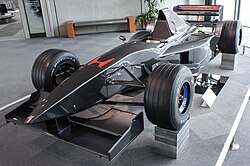Honda RC100
| Category | Formula One |
|---|---|
| Constructor | Honda |
| Designer(s) | Ken Hashimoto (project leader, Honda R&D) Keinosuke Taki (development chief, Honda R&D) |
| Technical specifications | |
| Engine | Honda RA121E V12 |
| Tyres | Bridgestone (for F3000) |
| Competition history | |
| Notable drivers | |
 | |
| Category | Formula One |
|---|---|
| Constructor | Honda |
| Designer(s) | Ken Hashimoto (project leader, Honda R&D) Keinosuke Taki (development chief, Honda R&D) |
| Technical specifications | |
| Engine | Honda RA122E V12 |
| Transmission | 6-speed Honda semi-auto |
| Tyres | Bridgestone (for F3000) |
| Competition history | |
| Notable drivers | |
 | |
| Category | Formula One |
|---|---|
| Constructor | Honda |
| Designer(s) | Ken Hashimoto (project leader, Honda R&D) Keinosuke Taki (development chief, Honda R&D) |
| Technical specifications | |
| Engine | Mugen-Honda V10 |
| Transmission | 6-speed Honda semi-auto |
| Tyres | Bridgestone (for F3000) |
| Competition history | |
| Notable drivers | |
The Honda RC100 was a prototype Formula One car built by engineers from Honda, although not as an official project. The car was completed in 1993 and tested at Honda's Suzuka Circuit before being destroyed in a crash test. Two more cars, known as RC101 and RC101B, were also built and tested before the project ended.
Later, Honda calls the RC100 as the "RC-F1 1.0X", the RC101 as the "RC-F1 1.5X", and the RC101B as the "RC-F1 2.0X". They are often called also the chassis numbers: RC1-203/1, RC1B-101, and RC2-001.
This cars should not be confused with the Honda RA099, which was an official Honda prototype intended for the 1999 season but also never ran.
History
During the 1992 season, Honda announced that they would end their engine supply programme that had existed since 1984. This was due to Honda's desire for a new challenge after dominating in Formula One, with Honda deciding to move to the CART championship in North America.
However, engineers at Honda decided to launch their own separate project by attempting to build a full Formula One car, something Honda had not done since the 1960s. Honda at the time encouraged engineers to create their own projects in an attempt to motivate and boost morale. Funds from Honda's motorsports budget were specifically put aside each year for engineers to be able to realistically create these projects. These projects were however not backed by Honda Motor Company, and the engineers actually had to work on their personal projects on their own time.
1991: RC-F1 1.0X (RC100)
1992: RC-F1 1.5X (RC101)
Members of Honda's chassis design team set about planning the RC100 chassis, attempting to fully comply with the 1993 Formula One regulations. The car used the same Honda RA122E/B V12 engine that was being used in Honda's engine supply program in 1992, but was joined with a six speed semi-automatic transmission built by Honda. This setup was identical to the 1992 McLaren Honda MP4/7A RA122E 3.5L V12 raced by Ayrton Senna and Gerhard Berger in the 1992 Formula One World Championship.
While the car was still being completed in 1992, Honda Motor Company president Nobuhiko Kawamoto acknowledged that the project existed, although it was confirmed to have had no backing from Honda. The completed RC100 was unveiled to select media in February 1993. Later that year, Honda engineers had the car crash tested by FISA in order to confirm that it indeed complied with the 1993 regulations.
1996: RC-F1 2.0X (RC101B)

Testing
The slightly evolved RC101 debuted later in 1993, with Honda factory driver Satoru Nakajima performing testing at the Suzuka Circuit, which Honda owned. Little is known about the performance of the RC101 in the hands of Nakajima before this chassis was also used in a crash test, destroying the car.
The first public testing came at Suzuka in January 1994, when yet another car had been built. The RC101B further evolved the design, with Nakajima performing the public test. Soon after, testing on the RC101B came to an end as Honda concentrated on their new CART program.
After testing
The RC100, RC101 and RC101B were planned to be destroyed after the demonstration running at the 2001 Honda Festival, annual social gathering of Honda companies, in Honda Automobile R&D Center, Tochigi. But, the plan was canceled, and all three RC-F1 cars are survived in Honda facilities; the RC100 was presented to Honda Technical College Kansai, and the RC101 and RC101B are owned by Honda Collection Hall.
References
- Honda Racing F1 [2006] Preview. Sony Magazines Inc. 2006. pp. 108–111. ISBN 4-7897-9752-X.
{{cite book}}:|access-date=requires|url=(help)
